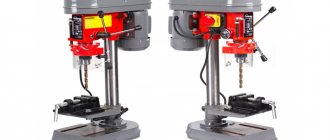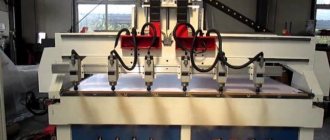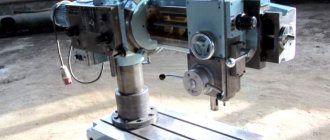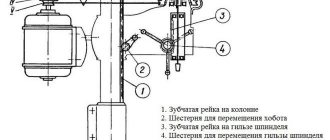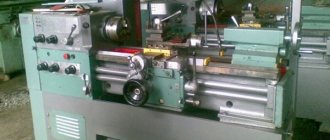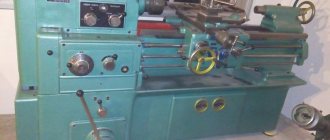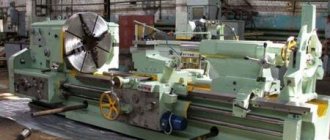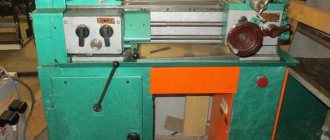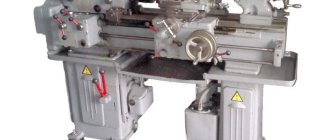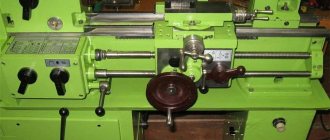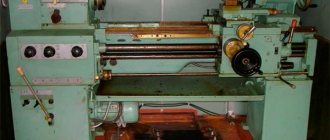Archive for machines
The universal horizontal boring machine 2A614-1 is designed for processing body parts with precise holes. interconnected by exact interaxal distances.
The largest mass of processed parts is 2000 kg.
The 2A614-1 machine, unlike the 2A615-1 machine, is equipped with a built-in faceplate with a radial support.
The machines have great versatility. They can be used for drilling, boring, countersinking and reaming holes, milling planes and grooves, as well as turning ends, boring holes and processing annular grooves with a radial support of the faceplate.
- The 2A614-1 machine, upon customer request, can be manufactured with a thread-cutting device.
- The presence of a mechanized tool clamp, rigidity, vibration resistance, speed and ease of control of the machine make it possible to carry out precise productive processing on them with the least amount of machine and auxiliary time.
- The machines are designed for use in tool and machine shops.
Technical characteristics of horizontal boring machine 2A614-1
Technical characteristics of machines are the main indicator of the suitability of a machine for performing certain jobs on machines. For horizontal boring machines, the main characteristics are:
- Table work surface size
- Retractable spindle diameter
- Maximum longitudinal movement of the spindle
- Spindle revolutions per minute
Below is a table with the technical characteristics of the 2A614-1 jig boring machine. More detailed technical characteristics of the machine can be found in the passport of the machine 2A614-1 located below.
| Name of parameters | Unit. | Quantities |
| Machine accuracy class according to GOST 8-77 | N | |
| Retractable spindle diameter | mm | 80 |
| The end of the retractable spindle with a cone for holding the tool | 40AT5, Morse 5 | |
| Built-in turntable dimensions (L x W) | mm | 1000×1000 |
| Vertical movement of spindle head | mm | 800 |
| Longitudinal movement of the retractable spindle | mm | 500 |
| Longitudinal movement of the built-in rotary table | mm | 1000 |
| Lateral movement of the built-in rotary table | mm | 1000 |
| Radial movement of the built-in faceplate support | mm | 125 |
| Retractable spindle speed | rpm | 20…1600 |
| Faceplate rotation speed | rpm | 6,3…200 |
| Feed limits of working bodies | mm/rev | 0,02…8 |
| Feed limits of the retractable spindle, spindle head, table in both directions. | mm/min | 1,26…2000 |
| Feed limits of the built-in faceplate caliper | mm/min | 0,5…800 |
| Speed of fast installation movements of the retractable spindle, headstock, table | mm/min | 5000 |
| Speed of fast installation movements of the built-in faceplate caliper | mm/min | 2000 |
| Maximum permissible torque on the retractable spindle | Nm | 865 |
| Maximum permissible torque on a triple faceplate | Nm | 1300 |
| Maximum permissible spindle feed force | kN | 7,5 |
| Maximum permissible table feed force | kN | 10 |
| The largest mass of the processed product | kg | 2000 |
| Overall dimensions of machines without attachments (LxWxH) | mm | 4518x2590x2585 |
| Weight of machines without electrical equipment and accessories | kg | 8500 |
Device design and features
The device of this type of unit includes the following elements:
- spindle;
- gearbox;
- base, workplace and column;
- drive unit;
- head for securing the tool;
- electrical cabinet;
- cooling system;
- gearbox;
- system that controls speeds and feeds;
- plunger oil pump.
The technical characteristics of vertical drilling machines indicate their versatility. These devices can perform not only drilling, but also countersinking, reaming, threading and reaming of holes.
This is due to the use of durable and hard tools made from well-cutting steels.
The ability to cut threads with machine taps is ensured by the reversibility of the spindle, thanks to which it can move in both directions.
The main features of the device are as follows:
- machine weight - 1199 kg;
- spindle torque can reach a maximum of 399 Nm;
- presence of a spindle stop system;
- the maximum permissible force at which the feed is performed is 15 kN;
- the use of an electric pump of the X14-22M type as part of the structure to transfer the cooling liquid to the processing site;
- The dimensions of the desktop are 449*499 mm, on the surface of which there are three grooves in the shape of the letter “T”.
One of the main technological features of the machine is its 100% manual control. All stages of work are adjusted manually, and the spindle feed is carried out mechanically.
General characteristics of the unit include three large parts:
- workplace-table on which the part to be processed is located;
- stable cast iron frame with space inside for electrical equipment;
- a drilling head with a spindle that moves vertically using a worm shaft.
Passport 2A135 (Ø 35 mm) Universal vertical drilling machine (Sterlitamak)
Name of publication: Description and maintenance manual Publication issue: Sterlitamak Machine Tool Plant named after Lenin Year of publication: 1960 Number of books (folders): 1 Number of pages: 31 Cost: Negotiable Description: Complete set of documentation
Description of the machine: The passport of the machine 2a135 is, albeit a rather rare publication, but nevertheless in demand for the operation and maintenance of a drilling machine of this model. It’s no secret that the 2A135 was produced at one time at an enterprise called the Sterlitamak Machine Tool Plant and was at that time an updated piece of equipment that replaced the equally well-known at that time, but more outdated machine model 2135. The presented drilling machine, in its updated configuration would be more productive in terms of working with metal, universal and unpretentious, which recommended this position to a wide variety of industrial enterprises with the highest quality supply. And this is not surprising, because the new design of the machine has acquired the most convenient way to control it, which certainly improved the ergonomic performance of the piece of equipment as a whole. At the same time, the machine works remarkably well with a drilling diameter of 35 millimeters, which allows it to cover a fairly wide range of metalworking capabilities, and this is actually an important aspect for any enterprise of one or another production focus.
The documentation for the machine itself is designated as a description and operating manual, which contains quite a lot of theoretical and, of course, practical information bordering on it. The fact is that theory is certainly a key factor for the concept of operating principles on any model of machine tool equipment, and these points were of course understood and taken into account by the machine developers, which were subsequently presented in the form of a detailed publication. In addition, moving from an operational focus to a focus related to the maintenance of machine equipment, here it is necessary to be guided not only by theory, but also by a practical approach to interaction on a drilling machine. And practice is the presence of all the necessary drawings and diagrams, on the basis of which the most productive option for working with the position of the equipment is possible. And just in the presented publication, of course, there are all the components necessary for production activities. These are circuits associated with both the mechanical and electrical parts of the machine. After all, the electrical equipment section is very important for working with electrical equipment that is located in the electrical cabinet, and the moments of restoration and even repair contribute to detailed information on the electrical circuit.
At the same time, in the manual you can find a number of drawings that influence the direction of the most rational work with the mechanics of the machine. These drawings have both general parameters and more detailed ones, which are designated as drawings of spare parts. In general, the documentation is a copy of the original and was translated by us into electronic format, which has high resolution and, of course, the possibility of a readable result when studying this technical literature. For this reason, it is possible to download a drilling machine passport from our electronic archive immediately after payment and receipt of the payment into our account. And we will be happy to provide a service in the direction of providing this or that documentation of interest, which is available in the company’s archive. In that case, if we consider such an important point as the use of 2A135 in production conditions, then the machine has the ability to process parts or workpieces that are quite small in size and weight associated with a metal base. And the machine itself can be successfully and actively used in small-scale production, repair, as well as tool shops of a wide variety of organizations related to the technological features of the industrial sector.
Techniques for drilling difficult-to-cut alloys
Difficult-to-process alloys include heat-resistant, titanium, stainless steels, etc. When drilling them with a standard drill, highly deformed strip chips are formed, wedged in the grooves of the drill, causing the occurrence of large cutting forces. This entails an increase in drill vibrations, which has a detrimental effect on the condition of its cutting edges, which quickly become dull. Therefore, difficult-to-cut alloys should be drilled taking into account the following recommendations:
- 1. Use special shortened (compared to standard) drills, the length of which should not exceed their diameter by more than 4-5 times.
- 2. Do not use drills that have been shortened as a result of regrinding standard drills. Shortening a standard drill results in an increase in the length of the transverse cutting edge due to the fact that the thickness of the bridge increases as it approaches the shank.
- 3. In the absence of special shortened drills, it is possible to put on and fasten rigid split bushings with an internal diameter equal to the diameter of the drill and an external diameter equal to 35..60 mm onto standard drills. The bushing must be secured close to the end of the chuck or machine spindle. The length of the sleeve depends on the length of the drill, but it is desirable that the part of the drill protruding from the sleeve does not exceed the diameter of the drill by more than 5..6 times.
- 4. To increase the durability of the drill, the width of its guide strips should be reduced to 0.2..0.4 mm, the clearance angle should be increased to 12° and double sharpening should be used.
- 5. To prevent jamming of chips, chip separating grooves should be cut on the rear surface of the drill (Fig. 86), dividing the chips widthwise into several parts; this improves the conditions for its removal from the hole.
- 6. To prevent chips from wrapping around the drill when leaving the hole, use a special chip breaker, which is a conical cap attached to the drill. The shavings, resting against the cap, break into short spirals.
- 7. Drilling should be carried out only with the use of cutting fluids. For heat-resistant alloys, a 50% emulsion or aqueous solution of barium chloride with the addition of 1% sodium nitrate is recommended; for titanium alloys, castor and sulfur oils, oleic acid or mixtures thereof are recommended.
Electrical equipment and electrical circuit of the drilling machine 2N118
Electrical diagram of drilling machine 2n118
The electrical equipment of the machine contains:
- spindle rotation electric motor 1M;
- electric cooling pump 2M;
- start-up and automation equipment;
- selenium rectifier SV;
- local lighting.
Control of drilling machine 2N118
The following controls are installed on the machine:
- control buttons - “Left”, “Right” and “Stop”;
- introductory machine;
- manual starter for turning on the cooling pump with “Start” and “Stop” buttons.
Braking the spindle of the machine 2N118
The machine uses a dynamic braking circuit with direct current supplied to three phases of the stator winding through the contacts of the SC brake starter from a selenium rectifier SV, which is powered by a step-down transformer TBS2-01. Simultaneously with the supply of DC current during braking, the stator winding is short-circuited in two phases for better braking efficiency. Braking occurs only when the ZKU or 2VK button is pressed.
Operation of the electrical circuit of the 2N118 machine
By pressing the 1KU “Right” button, the K1 starter is turned on, which is self-blocking with block contacts 6-7, and with contacts 4-16 it turns on the intermediate relay RP, which with its contacts 4-16 will become self-powered, and with contacts 14-9 it prepares the switching on of the K2 starter, if During operation on the machine, spindle rotation is reversed by pressing 1VK.
By pressing the 2KU “Left” button, the K2 starter is turned on, which is self-blocking with block contacts 4-9.
Whenever the spindle rotates to the right, left, pressing the “Stop” button, braking is performed, and K1 and RP are turned off if there was a rotation to the right, or K2 if the rotation was to the left. Through contacts 13, 17, 18, the short-circuit braking starter will turn on, which supplies direct current to the stator winding of the electric motor, and the engine will brake.
Protection
The electric motor is protected from overloads and short circuits by an AST-3 automatic switch. Zero protection is provided by a coil of magnetic starters.
The machine must be grounded in accordance with existing rules and regulations.
Equipment characteristics
Component Layout
The main parameters of the machine are described in detail in its passport and technical documentation. To operate the equipment, you should know that the maximum drill hole diameter can be 25 mm (for parts made of steel 45). In this case, the characteristics of the distance limits from the surface of the work table to the spindle cone range from 6 to 70 cm.
The large mass of the machine, 880 kg, gives the entire structure maximum stability and is the main factor in damping vibrations that occur during operation. At the same time, the dimensions of the structure allow it to be installed in the limited space of a production or repair shop. They measure 235*78.5*91.5 cm.
But the main passport characteristics of the 2N135 machine are the spindle parameters:
- maximum vertical movement – 17 cm;
- stroke – up to 20 cm;
- with one revolution of the flywheel, a displacement of 122.46 mm occurs;
- the number of speeds is 12;
- permissible torque is 250 Nm;
- the cone corresponds to Morse parameter 3.
The 2n135 machine has 12 feed stages. In this case, the vertical limits range from 0.1 to 1.6 mm with one spindle revolution. The design of the 2N135 machine is designed for manual control only.
Specifications
The good technical characteristics of this unit make it a completely acceptable option for an inexpensive vertical drilling machine, even in today’s conditions.
At industrial enterprises or in the workshops of folk craftsmen, you can often find a 2N135 that has undergone a major overhaul, in decent external and functional condition, produced over 30 years ago.
The main characteristics of any vertical drilling machines, on which their functionality directly depends, are the maximum drilling diameter, spindle stroke, number of revolutions per minute, maximum distance between the spindle and the working surface, and the dimensions of the latter.
Let's look at the 2N135 passport and figure out why this vertical drilling machine is remarkable in this regard.
Gearbox for vertical drilling machine 2N135
This drilling unit, as evidenced by the passport, is capable of drilling holes up to 35 millimeters in steel that complies with the GOST 1050-74 standard.
At the same time, the spindle overhang is 30 cm, and the maximum possible rise above the working surface is 250 cm, which allows processing large workpieces.
The remaining characteristics of the spindle are as follows:
- distance from the top point of the spindle to the work table: from 30 to 750 mm;
- distance from the top point of the spindle to the base plate: from 700 to 1120 mm;
- for one full turn of the control wheel, the spindle moves 122.46 mm;
- the operating speed range of the spindle, as evidenced by the passport, is from 31.5 to 1400 rpm;
- number of available spindle speed adjustments – 12 pcs.
Weight and dimensions characteristics of the vertical drilling machine 2N135:
- unit height at maximum spindle lift – 253.5 cm;
- unit width – 83.5 cm;
- unit length – 103 cm;
- machine weight – 1200 kilograms;
- desktop surface dimensions – 45×50 cm;
- The maximum table adjustment stroke along the vertical axis is 30 cm.
Technical characteristics of the power unit of the 2N135 machine:
- the machine is equipped with a 4A1001.4 electric motor with a power of 4 kW;
- for the motor to operate, a connection to a three-phase power supply of 380/220 Volts is required;
- The liquid cooling system is equipped with an electric pump of the X14-22M type, with a power of 0.12 kV, which is capable of pumping 22 liters of coolant per minute.
Regarding the surface of the desktop: three T-shaped slot fasteners are installed on it for additional equipment in accordance with GOST 1574.
Electronic circuit of the machine 2N135
Strengths and weaknesses of the machine
The undeniable advantages of this unit include endurance, durability and easy repairs.
Not every machine that appeared over 30 years ago can quite successfully replace modern drilling equipment.
Of course, the 2N135 is inferior to high-quality vertical drilling machines from good manufacturers in many respects, including ease of use, since the ergonomics of the new units is much better, drilling accuracy, and speed of operations.
However, if you choose a drilling machine for garage use or small production with an eye on three factors: functionality, reliability and minimal cost, then for comparable money you can hardly find a better option than 2N135.
Drilling machine 2N135
This machine, like all the equipment that came off the assembly lines of the Sterlitamak plant, was assembled conscientiously.
And there is every reason to believe that with proper care it will work efficiently for many more years.
The absence of any plastic parts, the use of which current manufacturers resort to in order to reduce the cost of construction, guarantees that the machine can be repaired in case of any breakdown.
The repair itself will cost you mere pennies, since the market is overfilled with components for this equipment.
Moreover, the design diagram, kinematic diagram and electrical diagram of the machine are freely available on the Internet, and if necessary, you can make the necessary part yourself.
Review of vertical drilling machine 2N135 (video)
data-full-width-responsive=”true” data-ad-client=”ca-pub-8514915293567855″data-ad-slot=”8040443333″>
Drilling equipment
In the machine park, a large percentage is occupied by the segment of drilling machines. This is explained by the need to carry out drilling in almost any technological process. All the necessary information related to the design of the unit is contained in the passport supplied with any model of the unit.
All equipment in this segment consists of three groups, each of which is distinguished depending on the specifics of the work:
- special;
- specialized;
- universal.
In each of these groups, gradation can be made depending on the size of the drill, and, accordingly, the holes that a given drilling machine can handle. Let's highlight the main ones:
- light, up to 12 mm;
- medium, 18-50 mm;
- heavy, over 50 mm.
Design features
The design of the drilling machine consists of:
- The working head, which serves to secure the tool.
- Drive unit.
- Plunger type oil pump.
- Cooling system for the treated area.
- Spindle.
- Gearbox.
- Unit power supply system, electrical cabinet for connecting to the network.
- Gearbox.
- Speed and feed control system.
- Base plate, column, work table.
The unit frame is made in the form of a monolithic, massive, cast-iron structure. The position of the productive surface is carried out by the operator on the supporting column manually, by pressing the locking device and turning the steering wheel, which performs the function of adjusting the position of the spindle. To move the table surface, special guide grooves are made on the column.
The base plate is also cast iron. It has a hollow structure, inside of which there is a container for storing cooling liquid. There is also a settling tank for large metal contaminants and a filtration device. On the support column itself there is an electric pump with a power of 120 W, which is responsible for supplying the liquid. The coolant is supplied through a system of tubes of various diameters, which supply water directly to the drilling element.
The power unit of the machine is located on the top of the body. The spindle block and gearbox of the machine are located in the housing. The kinematic diagram of the equipment has a simple design solution, in which the power unit and the speed box are connected by a straight shaft. Mechanical speed adjustment is carried out using a handle located on the front side of the drilling head. Speed adjustment is done manually. The box transmits spindle rotation speed at twelve frequencies.
The operating elements of the unit are lubricated using a plunger pump in automatic mode. The operator will only need to monitor the oil level using the sensor located on the front panel.
This model has a manual spindle feed system. This system includes:
- A steering wheel that performs an adjustment function.
- Worm-like transmission.
- Overrunning ratchet and dog clutch.
- Limba.
- Shaft, horizontal, with rack and pinion gear.
Operation and repair
The operation of the device begins with its column, which performs the function of fixing it on the floor surface. The column is made of cast iron. The work table, which is attached to the column, moves together with the drilling head using a manual drive.
The movement occurs along the column itself. The plate, which plays the role of the base, has an internal cavity in which a special cooling liquid is located. A sump tank is also installed there. An electric pump system is attached to the upper part of the base plate, with the help of which, during operation of the machine, coolant is supplied to the workpieces.
The feed box is installed separately in a special housing located in the working head.
The second main technique for operating the 2n135 machine involves operating the feeder. It includes the following elements:
- 2 couplings, one of which is ratcheting, the other is overrunning;
- steering wheel for control;
- rack-and-pinion gear located on a horizontal shaft;
- worm-gear;
- limba having divisions.
Limba
Thanks to the feeder, the scheme of working with the machine implies a wide range of actions:
- switching off, switching on feed;
- cutting threads on the product itself using the manual feed method;
- spindle retraction upwards from the workpiece;
- bringing the processing tool to the product manually;
- performing advance feed manually.
The mechanism works as follows: the jaw clutch is driven by a rotating handwheel. The clutch then drives a gear, which is connected to a rack, which feeds the spindle.
All this is done manually. When the processing tool impacts the workpiece, the gear rotates. Movement occurs along the axis of the shaft until the moment when the cams of the coupling itself are opposite each other. At this moment the clutch turns 2000.
In cases where the machine was repaired, it is necessary to check its components. It is important to ensure that there are no traces of corrosion on the device. After repair work, the unit runs idle, and the cutting tool is not installed. During a test run, the operation of the device is checked against the data in its technical passport.
Kinematic diagram of the drilling machine 2A135
Kinematic diagram of the drilling machine 2A135
Kinematic diagram of the 2A135 drilling machine. View enlarged
Movements in the machine
- Cutting movement - rotation of the spindle with the cutting tool
- Feed movement - axial movement of the spindle with the cutting tool
- Auxiliary movements are manual movements of the table and spindle head in the vertical direction and rapid manual movement of the spindle along its axis.
Cutting movement. Spindle V (Fig. 55, a) is driven by an electric motor with a power of 4.5 kat through a V-belt drive 140-178 and a gearbox.
On shaft I of the gearbox there is a triple movable block of gears B1, which provides shaft II with three rotation speeds. From shaft II, through gears 34-48, rotation is transmitted to shaft III, on which a triple movable gear block B2 is located, driving hollow shaft IV, connected by a spline to spindle V. As can be seen from the graph (Fig. 55, b), spindle V has nine rotation speeds. The highest number of spindle revolutions nmax, taking into account the elastic sliding of the belt, is determined from the expression = 1070 rpm.
Feeding movement. The feed movement is borrowed from spindle V. The movement is transmitted through gears 27-50 and 27-50, feed box with sliding keys, safety clutch M1, shaft IX, worm gear 1-47. gear coupling M2, shaft X and rack and pinion transmission to the spindle sleeve.
The feed box contains three- and four-stage mechanisms with sliding keys.
From shaft VI, three rotation speeds are transmitted to shaft VII, on which gears 60, 56, 51, 35 and 21 are rigidly fixed. From shaft VII, four rotation speeds are transmitted to shaft VIII.
Theoretically, the feedbox provides 12 rotation speeds, however, as can be seen from the graph (Fig. 54), one of them is repeated, so the 2A135 machine has only 11 different feed rates.
From shaft VIII, through the jaw clutch M1, movement is transmitted to shaft IX, on which the worm is fixed. The worm wheel is located on the same shaft with rack and pinion gear 14, which is in mesh with a rack cut on the spindle sleeve. The M1 clutch is used to protect the feed mechanism from damage during overloads, as well as to automatically turn off the feed when working on stops.
The highest feed rate smax is determined from the expression 3.14*3.5*14 = 1.6 mm/rev.
Auxiliary movements. The spindle head is moved from handle P1 through a worm gear 1-32 and rack and pinion gear 18, which engages with a rack m=2 mm fixed to the frame.
Vertical movement of the table is achieved by turning handle P2 through shaft XI, bevel gears 16-43 and lead screw XII.
Rapid movement of the spindle with the sleeve is carried out by a handwheel Ш connected by a special lock to shaft X. The lock allows the handwheel to rotate freely on shaft X within 20°, and subsequently connects them into one whole.
Electrical equipment and electrical circuit of the drilling machine 2N135
Electrical diagram of drilling machine 2N135
Electrical diagram of a drilling machine 2N135. View enlarged
Description of the operation of the electrical circuit of the machine
By turning on the input circuit breaker B1, voltage is supplied to the main and auxiliary circuits, and the signal lamp lights up. If cooling and lighting are required, the corresponding switches are placed in the “ON” position. By pressing the Kn2 “RIGHT” button, the starter coil P1 receives power, the main contacts turn on M1 for right rotation of the spindle. Through the block contacts P1, the starter P5 is turned on, which turns on the electric pump M2 and the delay relay P12.
When you press the KnZ “LEFT” button, the starter P1, the electric motor M1, the relay P12 are turned off after the capacitor C3 is discharged, the contacts of the relay P12 (28-26) are closed and the starter P2 and M1 are turned on for left-hand rotation. Relay P12 turns on again.
With automatic reverse, these switches occur when microswitch B4 is triggered by a cam mounted on the dial.
Stopping is carried out by pressing the Kn1 “STOP” button, this turns off the starters P1 or P2, P5, turning off M1, M2. Through relay contacts P12 (7-9), relay P11 is switched on, followed by switching on starters P3 and P4. The windings of the electric motor M1 are connected through rectifiers D1, D2 to the transformer Tr2, and dynamic braking occurs. After the discharge of capacitor C1, C2, relay P11 is turned off, disconnecting starters P3, P4 and M1 from the brake circuit.
When switching speeds, if the gears do not engage, a stepwise rotation of the electric motor rotor is used. By pressing the Kn4 “CURVE” button, the starter P4 is turned on, and a reduced rectified voltage flows through phases 1C2-1C3. Through resistance P2, relay P11 is turned on with a delay, turning off starter P4 and turning on P3 - the voltage flows through phases 1C1-1C2. Such switchings provide swinging of the rotor and kinematics, which makes it easier to change speeds.
Thermal relays are used to protect against overload. For zero protection - coils and contacts of magnetic starters.
Information about the manufacturer of the vertical drilling machine 2Р135Ф2
The manufacturer of drilling machines models 2Р135Ф2, 2Р118Ф2, 2Н125, 2Н135, 2Н150, 2Г175 is the Sterlitamak Machine Tool Plant, founded in 1941.
The history of the Sterlitamak Machine Tool Plant begins on July 3, 1941, when the evacuation of the Odessa Machine Tool Plant to the city of Sterlitamak began.
Already on October 11, 1941, the Sterlitamak Machine Tool Plant began producing special modular machines for the defense industry.
Currently, the plant produces metalworking equipment, including drilling and honing machines, CNC lathes and milling machines, multifunctional machining centers, metalworking and cutting tools.
Products of the Sterlitamak Machine Tool Plant
- 2135
— universal vertical drilling machine Ø 35 - 2A125
- universal vertical drilling machine Ø 25 - 2A135
- universal vertical drilling machine Ø 35 - 2A150
- universal vertical drilling machine Ø 50 - 2G175
- universal vertical drilling machine Ø 75 - 2N125
- universal vertical drilling machine Ø 25 - 2N135
- universal vertical drilling machine Ø 35 - 2N150
- universal vertical drilling machine Ø 50 - 2R135F2
- CNC vertical drilling machine Ø 35 - 2S125, 2S125-1 (2S125-01), 2S125-04
- universal vertical drilling machine Ø 25 - 2S132, 2S132K
- universal vertical drilling machine Ø 32 - 2С150ПМФ4
- vertical drilling-milling-boring machine with CNC and ASI 500 x 1000 - 400V
- vertical drilling-milling-boring machine with CNC and ASI 400 x 900 - SF-16, SF-16-02, SF-16-05
- tabletop milling and drilling machine Ø 16
Purpose, operating principle, design of the 2N135 machine
Historical reference
The vertical drilling machine model 2N135 is secretly considered the “workhorse” of all mechanical sections of engineering production. The design of the machine is characterized by maximum simplicity and reliability, and the kinematic diagram of the gearbox and gearbox of the machine is still unparalleled.
Production of the basic model 2135 began in 1945 at the Sterlitamak plant. After this, based on operational data, modernization work was carried out. Since 1965, production of the 2N135 model began.
Operating principle
Operation of the machine in operating mode occurs according to the following principle. The workpiece to be processed must be installed and securely fixed on the working surface of the coordinate table. The spindle with the installed tool should be located in the lowest position. Using the worktable longitudinal displacement system, the spindle must be centered.
Then you need to make sure that the end of the part to be processed and the spindle are coaxially positioned. Based on the kinematic possibilities, in the high-speed gearbox we select the rotation speed suitable for processing. We turn on the vertical electric motor of the main drive.
After setting up the kinematic diagram, the tool head moves to the end of the workpiece, and the desired technological operation is performed.
Modifications
The great popularity of this equipment in industrial and domestic use was the first reason for the release of a huge number of modifications. These models include:
- 2N135−1 - this model differs from the original only in the presence of a round table with a rotary action, which can be wrapped around a supporting column.
- 2E135A - this machine is equipped with an automatic spindle feed system. The operator can control the equipment using push-button controls.
- 2N135K is a vertical drilling machine of coordinate type equipped with a cross working plane.
- 2N135N is a multi-position vertical drilling machine, the operator of which can freely move the functional parts of the equipment around the supporting column.
- 2N135F2 is drilling equipment with numerical control (CNC). A modification that has a revolving-type working head, as well as a cross surface. This model is considered the most modern in many respects.
- 2N135-S - the unit is similar in all respects to the base model, only it has a flange-type quill. A distinctive feature is the ability to install the working head on several spindles simultaneously.
2A135 Universal vertical drilling machine. Purpose and scope
The 2A135 vertical drilling machine replaced an outdated machine in mass production 2135
.
The new model provides more convenient control of the feed and feed box. Improved ergonomics. The 2A135 machine was replaced by a more advanced model 2N135.
The universal vertical drilling machine, model 2A135, is designed for work in repair and tool shops, as well as in production shops with small-scale production; a machine equipped with accessories can be used in mass production.
Vertical drilling machine 2a135, with a nominal drilling diameter of 35 mm, is used in enterprises with single and small-scale production and is designed to perform the following operations: drilling, reaming, countersinking, countersinking, reaming, threading and trimming ends with knives.
Allows processing of parts in a wide range of sizes from various materials using tools from high-carbon and high-speed steels and hard alloys.
Drilling operations on machine 2a135
Design features of the drilling machine 2A135
The presence on the machine of a nine-speed gearbox with a control range of 68-100-140-195-175-400-530-750-1100 rpm, an 11-speed feed box with a control range of 0.115 to 1.6 mm per revolution and electric reverse provides selection of standard cutting modes for hole diameters up to 35 mm when drilling, reaming, countersinking, countersinking, reaming, threading, and also allows the use of cutting tools equipped with carbide.
The presence of mechanical spindle feed on machines, with manual control of work cycles.
Allows processing of parts in a wide range of sizes from various materials using tools from high-carbon and high-speed steels and hard alloys.
The machines are equipped with a device for reversing the main motion electric motor, which allows them to cut threads using machine taps while manually feeding the spindle.
The machine has high rigidity, strength of working mechanisms, drive power and a wide range of cutting speeds and feeds, allowing the use of cutting tools equipped with carbide. The presence of an electric reverse, controlled both automatically and manually, provides the ability to cut threads with manual approach and withdrawal of the tap.
The design of the vertical drilling machine model 2A135 provides for automatic switching on of the feed movement after the cutting tool is quickly brought to the workpiece and automatic switching off of the feed when the specified drilling depth is reached.
The specified drilling depth for blind holes is ensured by a special stopping mechanism with a stop. This mechanism is also a safety device that protects the feed mechanism from damage due to overload.
The machine spindle is mounted on precision rolling bearings. The lower support consists of a radial ball bearing of class AB. The upper support has one class B ball bearing.
The plant provides the possibility of changing the drive pulleys of the belt drive, which allows you to set the limits of the spindle speed in accordance with the technological tasks.
To reduce auxiliary time on the machine model 2A135, it is possible to turn the feed on and off using the same steering wheel that manually moves the spindle quickly.
Placement category 4 according to GOST 15150-69.
Where is it used?
Single-spindle machines 2n135 are often used in enterprises that engage in small-scale or single-piece production. They are practically not used in mass production.
The equipment is designed to perform a number of operations, be it drilling, countersinking, countersinking, trimming or reaming. The equipment of the Sterlitamak plant is a universal solution for implementing many production tasks. The machine operator can independently select the speed and feed mode of the spindle, which makes it possible to configure the operation of the equipment for optimal processing of a specific material or obtaining a specific hole. In this case, the master can manually feed the spindle, thanks to a specially designed mechanism.
The 2n135 vertical drilling machine has an important advantage - it is capable of processing parts from a wide variety of materials in a wide range of dimensions. The technology demonstrates particularly high performance when working with tools made of high-carbon steel. The operator can also cut threads using machine taps by feeding the spindle by hand. This became possible due to the fact that the machine is equipped with an electric motor reversing system.
This is interesting: Modern metal milling machines - types, features, purpose
